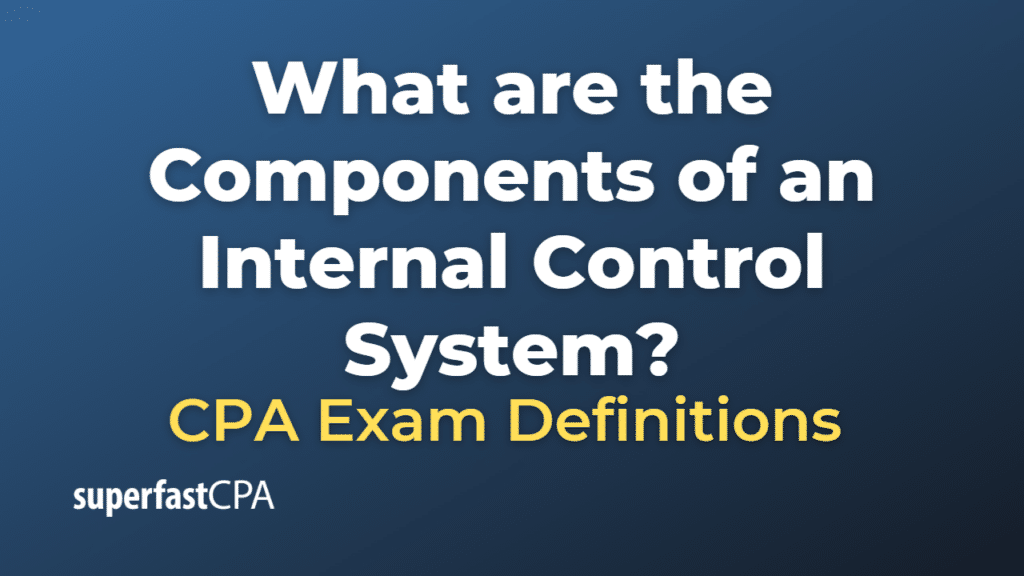Components of an Internal Control System
An internal control system is a set of policies, procedures, and mechanisms designed to help an organization achieve its objectives, maintain reliable financial reporting, safeguard assets, ensure legal and regulatory compliance, and promote operational efficiency and effectiveness. Internal control systems are essential for maintaining the integrity of an organization’s operations and reducing the risk of fraud, errors, and mismanagement.
There are five key components of an internal control system, as identified by the Committee of Sponsoring Organizations of the Treadway Commission (COSO) in its Internal Control – Integrated Framework. These components are:
- Control Environment: The control environment sets the tone for the organization, influencing the overall attitude and behavior of employees regarding internal controls. It includes factors such as organizational structure, management’s philosophy and operating style, ethical values, integrity, and competence of employees, and the board of directors’ oversight. A strong control environment is crucial for establishing a foundation for effective internal controls.
- Risk Assessment: Risk assessment involves the identification, analysis, and management of risks that could hinder the achievement of an organization’s objectives. This includes both internal and external risks, such as changes in the regulatory environment, market conditions, technological advancements, or internal factors like employee turnover or system failures. Management should continuously assess risks and implement appropriate controls to mitigate their potential impact on the organization.
- Control Activities: Control activities are the specific policies, procedures, and mechanisms designed to address the risks identified during the risk assessment process. They include a wide range of actions, such as segregation of duties, authorization and approval processes, physical safeguards, information system controls, and performance reviews. Control activities help ensure that management’s directives are carried out and that necessary actions are taken to address the identified risks.
- Information and Communication: Effective information and communication systems are essential for the successful implementation of internal controls. They ensure that relevant, accurate, and timely information is identified, captured, and communicated throughout the organization, enabling employees to understand their roles and responsibilities and make informed decisions. Communication should flow in all directions – from management to employees, from employees to management, and between different departments or functions within the organization.
- Monitoring: Monitoring involves the ongoing review and evaluation of the internal control system to ensure its effectiveness and to identify any deficiencies or areas for improvement. This can be achieved through ongoing activities, such as management supervision, or through separate evaluations, like internal or external audits. Regular monitoring helps ensure that internal controls continue to operate effectively and enables the organization to address any issues in a timely manner.
An effective internal control system is essential for organizations to achieve their objectives, maintain the reliability of their financial reporting, and ensure compliance with laws and regulations. By incorporating these five components into their internal control system, organizations can minimize risks, enhance operational efficiency, and foster a culture of accountability and responsibility.
Example of the Components of an Internal Control System
Let’s consider a hypothetical example of a retail company, RetailCo, which has implemented an internal control system to manage its operations effectively and reduce the risk of fraud, errors, and mismanagement.
- Control Environment:
- RetailCo’s management establishes a clear organizational structure with defined roles and responsibilities for each employee.
- The company maintains a code of conduct and ethics policy, which is communicated to all employees during orientation and reinforced through ongoing training.
- The board of directors provides oversight and actively engages with management to ensure the effectiveness of internal controls.
- Risk Assessment:
- RetailCo identifies the risk of inventory theft as a significant concern and assesses the potential impact on its profitability and reputation.
- The company also recognizes the risk of inaccurate financial reporting, which could lead to incorrect decision-making and potential regulatory penalties.
- Control Activities:
- To address the risk of inventory theft, RetailCo implements physical safeguards, such as security cameras and access controls, and enforces strict inventory management procedures.
- The company establishes a system of authorization and approval for financial transactions to prevent errors and fraud.
- RetailCo ensures segregation of duties, so that no single employee has control over an entire transaction process, reducing the risk of fraud and errors.
- Information and Communication:
- RetailCo implements an effective information system that captures and communicates relevant financial and operational data throughout the organization.
- The company encourages open communication channels for employees to report any concerns or issues related to internal controls or potential fraud.
- Monitoring:
- RetailCo’s management regularly reviews operational and financial reports to detect any anomalies or issues that could indicate control weaknesses or fraud.
- The company conducts periodic internal audits to assess the effectiveness of its internal control system and identify areas for improvement.
- RetailCo also engages an external auditor to perform an annual audit of its financial statements and internal controls, providing an independent assessment of the company’s internal control system.
By implementing these five components of an internal control system, RetailCo can manage its operations effectively, reduce the risk of fraud and errors, maintain the reliability of its financial reporting, and ensure compliance with relevant laws and regulations. This, in turn, helps the company achieve its objectives, safeguard its assets, and maintain a strong reputation in the retail industry.












